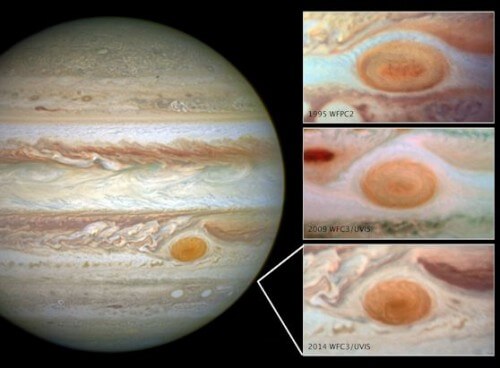The current diameter of the Great Red Spot is about 16,500 km, about half of its size a hundred years ago

Jupiter's hallmark - the Great Red Spot, an anticyclonic swirling storm larger than Earth has shrunk to its smallest size since measurement began.
According to Amy Simon of NASA's Goddard Space Flight Center in Maryland, recent observations by the Elbe Space Telescope have confirmed that the current diameter of the Great Red Spot is about 16,500 km, less than half its size in historical measurements. Astronomers have been following this shrinking since the 20s.
Images of Jupiter's Great Red Spot taken by the Hubble Space Telescope over the past 20 years show the spot shrinking.
The observations of the spot began at the end of the 19th century and the measurements of that time show that the diameter of the spot along its long axis was 41 thousand km. The pair of spacecraft Voyager 1 and Voyager 2 that passed by Jupiter in 1979 measured the diameter of the spot at about 23,300 km. In 1995, the Hubble Space Telescope measured the long axis of the spot and measured its size at about 21 thousand km. In the photos from 2009, a diameter of 17,900 km was measured.
At the beginning of 2012, observations by amateur astronomers revealed a significant increase in the rate of contraction, and it stands at about 933 km per year, and it also changed its shape from elliptical to circular.
"In our new observations, smaller eddies are visible that feed the storm," says Simon. "We hypothesize that this phenomenon is responsible for accelerating the changes and changing the internal dynamics and energy of the Great Red Spot."
Simon's team plans to measure the small eddies and the internal dynamics of the storm to determine whether these eddies can feed the momentum or dig in and stop it as they enter the eddy waves, which might cause the unexplained contraction.
NASA's Juno spacecraft is speeding toward Jupiter these days, and is scheduled to reach the giant planet in July 2016. A dedicated instrument on the spacecraft may reveal the mystery.

7 תגובות
D.H.
What does life have to do with turbulence in Jupiter? The vortex is not alive.
Everything ends in the end, and the "Great Red Spot" vortex that has existed on Jupiter at least since Galileo's time - is also going to die. As the beginning of the process, it begins to "give birth" to small vortices that feed on the energy of the mother vortex and accelerate the decay process. In the end, only small eddies will remain, but it is also possible that one of them will quickly overcome the rest and become a "big human spot" that will last hundreds/thousands of years.
Life is not only the biological system of the earth. Life can exist upstream wherever there is an energy cascade.
Reading - there are more terrible reactions from all kinds of followers of gurus of all kinds, laughing still does no harm.
Remove stupid and shallow comments like the above
One can only hope that it did not completely fall off in the wash
It's pretty obvious why. After tonight's game all the red spots are shrinking.